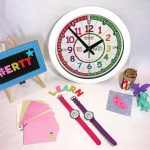
Time telling assistance for dyslexic children
Learning to read an analog clock is an important part of child development, but for many youngsters this can be a difficult and frustrating process.
This is particularly true of children with Dyslexia, who can struggle to learn to tell the time easily when using a clock that has hands and numbers.
Here we look at some of the issues dyslexic children encounter when learning to tell the time, and how our range of teaching products can help.
Challenges facing dyslexic children
There are a few primary challenges that make it difficult for children with Dyslexia when learning to tell the time using a standard analog clock face, these include:
- Issues when distinguishing between the minute and hour hands
- Confusion with concepts such as before (to) and after (past)
- Difficulty identifying smaller units of time such as 1.01, 1.02, 1.03 etc
- Struggles with linguistic codes such as ‘clockwise’ and ‘quarter-past’
These issues can cause dyslexic children to feel frustrated and embarrassed when learning to tell the time and often discourages them, so teaching aids can be a highly effective method of developing understanding and familiarity in a fun way.
How our products can help
Our team have spoken to many parents, teachers and SEN specialists to find out how they feel EasyRead products and our adapted teaching system helps dyslexic children to learn to tell the time.
The overall feedback suggested that our products could offer significant assistance with dyslexic children or pupils for the following reasons:
- Our products and teaching system are highly appealing to children, encouraging participation
- The numbers used on our clock and watch faces are large and visible
- It is beneficial to have 1-5 in each segment for the ‘past’ and ‘to’ and 1-59 on the 24 hour
- Use of distinguished red and blue colouring for the ‘minutes to’ and ‘minutes past’
- Use of fractions to help familiarise with the concept of ‘quarter-past’, ‘half-past’ etc
- There is no ticking sound, which dyslexic children can find distracting
Perhaps the most important thing that we have learned from parents and teachers is that Dyslexia is not a straightforward condition, as it can vary dramatically from person to person. However, the majority of feedback has suggested that with practice and perseverance our products can contribute considerably to helping dyslexic children to tell the time.
Find out more
If you would like to find out more about our range of ‘learn to tell the time clocks’ and how they can help dyslexic children to develop their time telling skills, please contact our friendly team on 01684 566832.